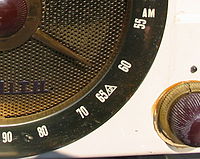https://en.wikipedia.org/wiki/Blast_shelter
Why does the National Media put scare to our daily run as the Hare Read have not confirmed a process to communicate outside of their possession of attention; sew.
CONELRAD
From Wikipedia, the free encyclopedia
For the band, see Conelrad (band).
CONELRAD (Control of Electromagnetic Radiation) is a former method of emergency broadcasting to the public of the United States in the event of enemy attack during the Cold War. It was intended to allow continuous broadcast of civil defense information to the public using radio or TV stations, while rapidly switching the transmitter stations to make the broadcasts unsuitable for Soviet bombers that might attempt to home in on the signals (as was done during World War II, when German radio stations, based in or near cities, were used as beacons by pilots of bombers).
U.S. president Harry S. Truman established CONELRAD in 1951. After the development of intercontinental ballistic missiles reduced the likelihood of a bomber attack, CONELRAD was replaced by the Emergency Broadcast System on August 5, 1963, which was later replaced with the Emergency Alert System on January 1, 1997; all have been administered by the Federal Communications Commission (FCC).[1]
Unlike its successors, the EBS and EAS, CONELRAD was never intended to be used for severe weather warnings or local civil emergencies.
Contents
[hide]History[edit]
Prior to 1951, there was no method that the U.S. government could use to broadcast warnings to citizens in the event of an emergency. However, radio stations and networks could interrupt normal programming and issue a bulletin in the event of an emergency, as happened during the attack on Pearl Harbor on December 7, 1941, as well as the first successful tornado warning near Tinker Air Force Base in 1948. This type of broadcasting was the forerunner to CONELRAD.
The CONELRAD concept was originally known as the Key Station System. According to an FCC document created during the "Informal Government–Industry Technical Conference" on March 26, 1951:
- "The primary plan for alerting broadcast stations that is currently being considered by the FCC Study Group is known as the Key Station System. The arrangement requires certain telephone circuits (private wire or direct line to Toll Board) between the Air Defense Control Centers (A.D.C.C.) and specified radio stations to be known as "Basic Key Stations".
- Additional telephone circuits (direct line to Toll Board) will be required in certain cases, between "Basic Key Stations" and other stations to be known as "Relay Key Stations". Each "Basic Key Station" receiving an alert or warning signal from the A.D.C.C. shall, if so directed, proceed to broadcast a predetermined message and also relay the message by telephone to all "Relay Key Stations" under his control as specified." CONELRAD was officially introduced on December 10, 1951.[2]
CONELRAD had a simple system for alerting the public and other "downstream" stations, consisting of a sequence of shutting the station off for five seconds, returning to the air for five seconds, again shutting down for five seconds, returning to the air again, and then transmitting a 960 Hz tone for 15 seconds. Key stations would be alerted directly. All other broadcast stations would monitor a designated station in their area.
In the event of an emergency, all United States television and FM radio stations were required to stop broadcasting. Upon alert, most AM medium-wave stations shut down. The stations that stayed on the air would transmit on either 640 or 1240 kHz. They would transmit for several minutes and then go off the air, and another station would take over on the same frequency in a "round robin" chain. This was to confuse enemy aircraft who might be navigating using radio direction finding. By law, radio sets manufactured between 1953 and 1963 had these frequencies marked by the triangle-in-circle ("CD Mark") symbol of Civil Defense.[3]
Although the system by which the CONELRAD process was initiated (switching the transmitter on and off) was simple, it was prone to numerous false alarms, especially during lightning storms.[4] Transmitters could be damaged by the quick cycling. The switching later became known informally as the "EBS Stress Test" (due to many transmitters failing during tests) and was eventually discontinued when broadcast technology advanced enough to make it unnecessary.
Beginning January 2, 1957, U.S. amateur radio came under CONELRAD rules and amateur stations were also required to stop transmitting if commercial radio stations went off the air due to an alert. Several companies marketed special receivers that monitored local broadcast stations, sounding an alarm and automatically deactivating the amateur's transmitter when the broadcast station went off the air.[5]
In a Time magazine article featured in the November 14, 1960 issue, the author details why the warning system consisting of localized Civil defense sirens and the CONELRAD radio-alert system was "basically unsound".[6] The author's alternative was to advocate for the National Emergency Alarm Repeater as a supplement, which did not need a radio or television to be switched on to warn citizens, nor a large CD siren to be in their vicinity.





